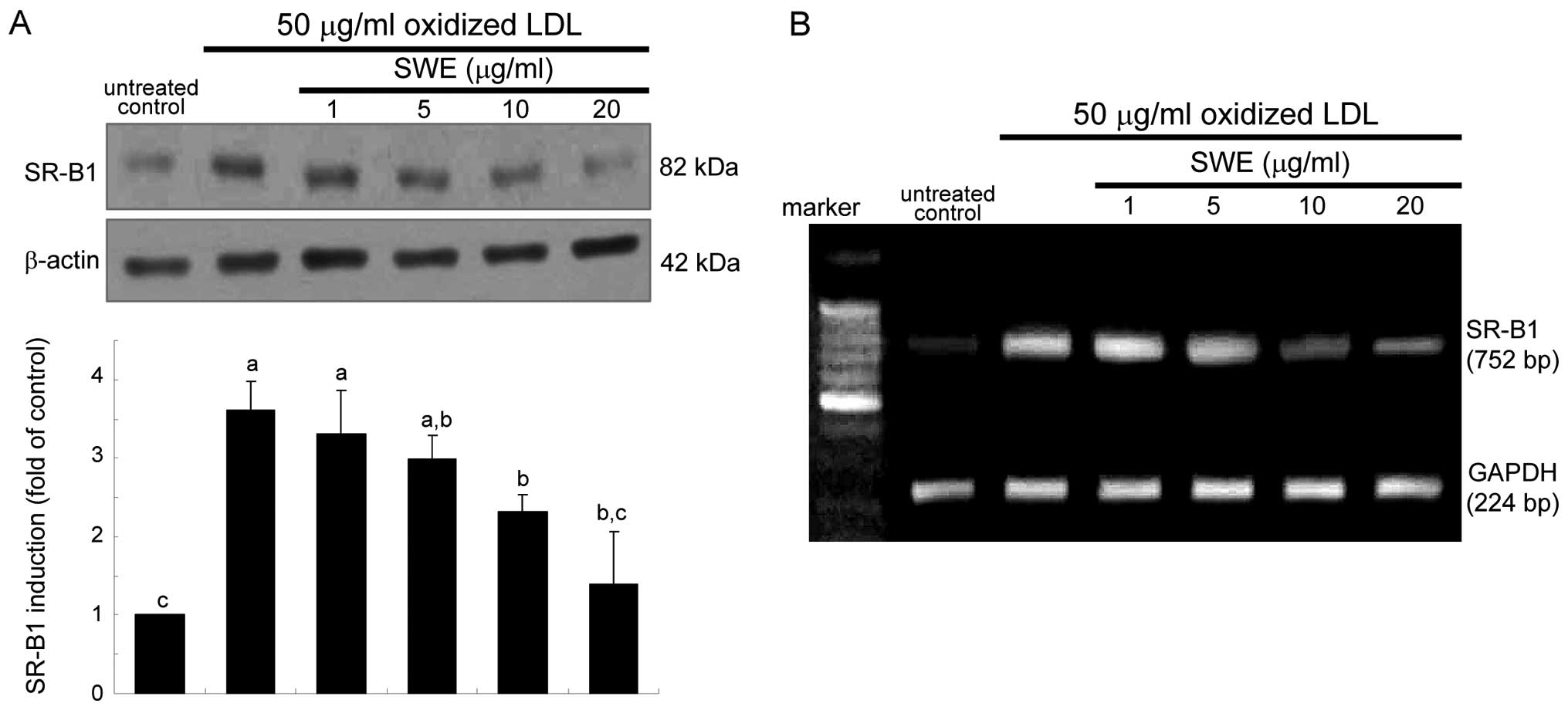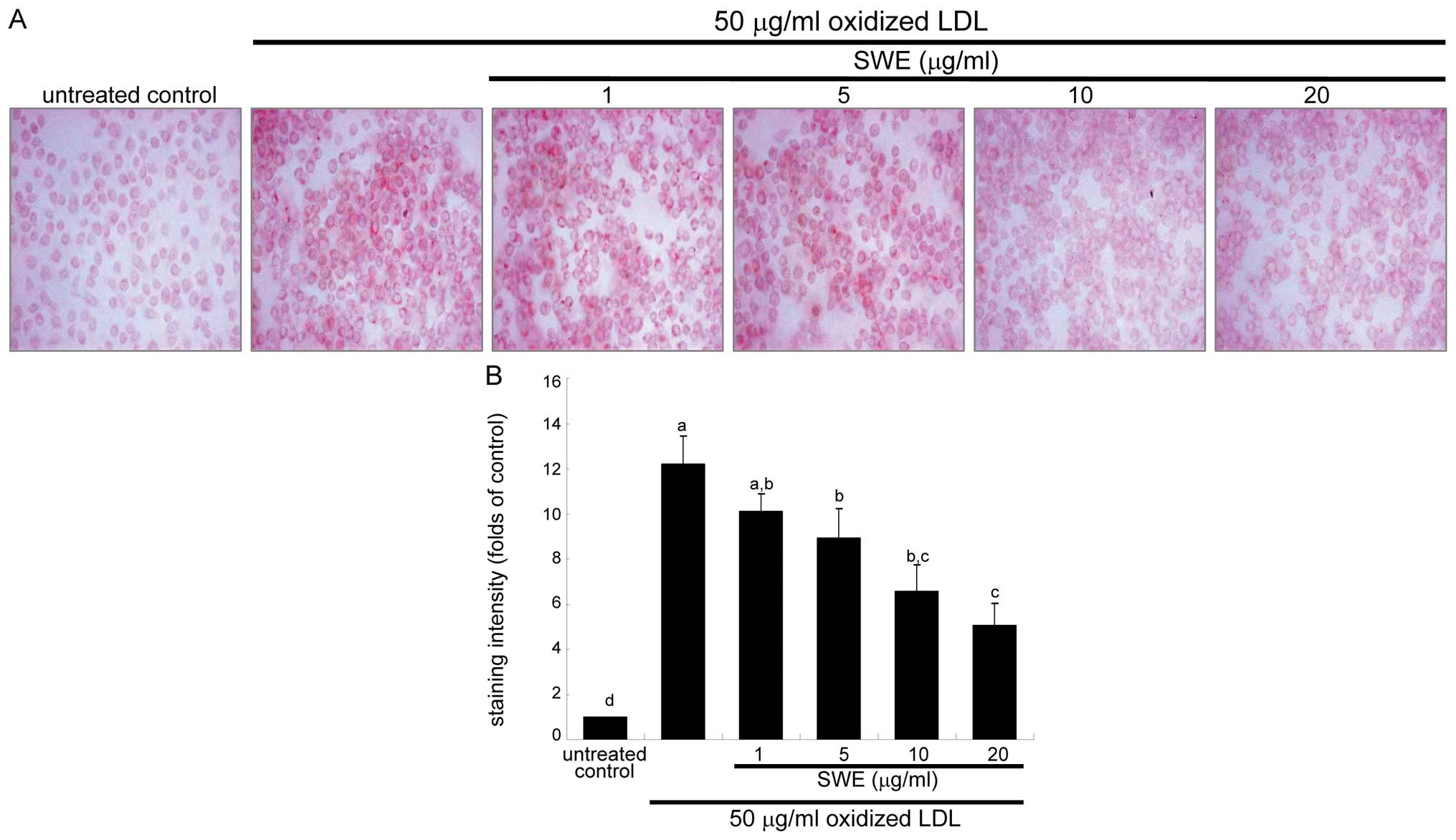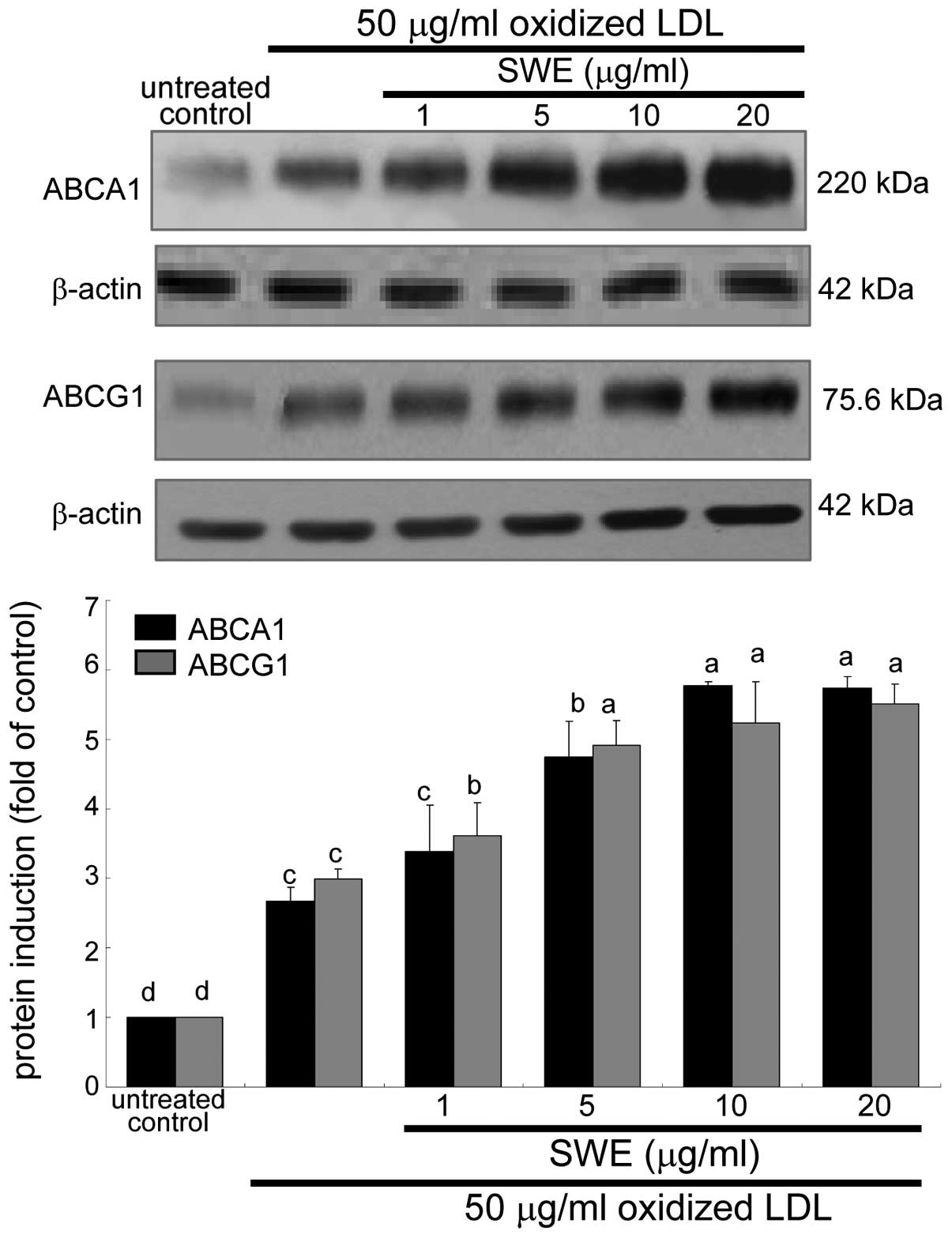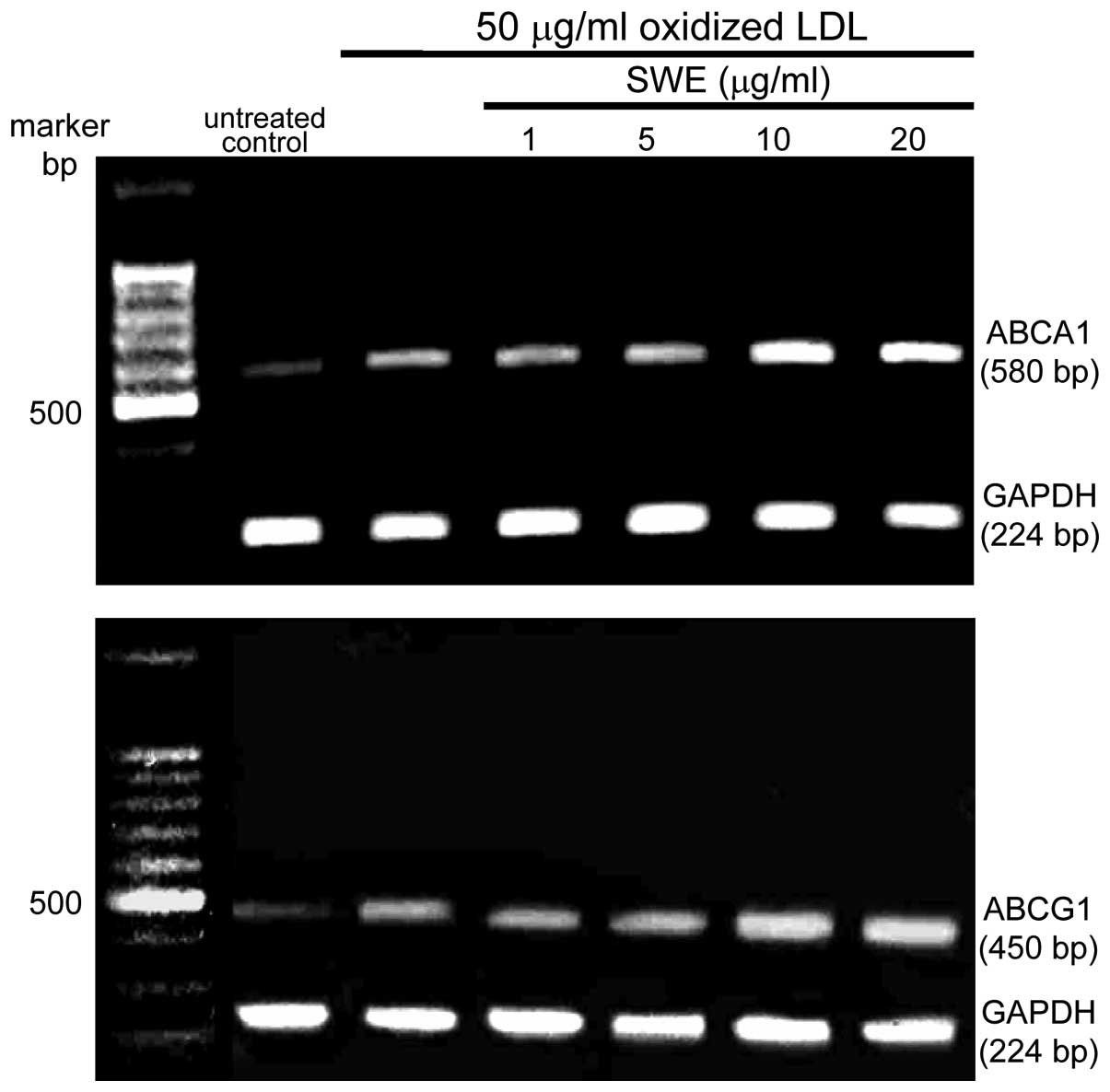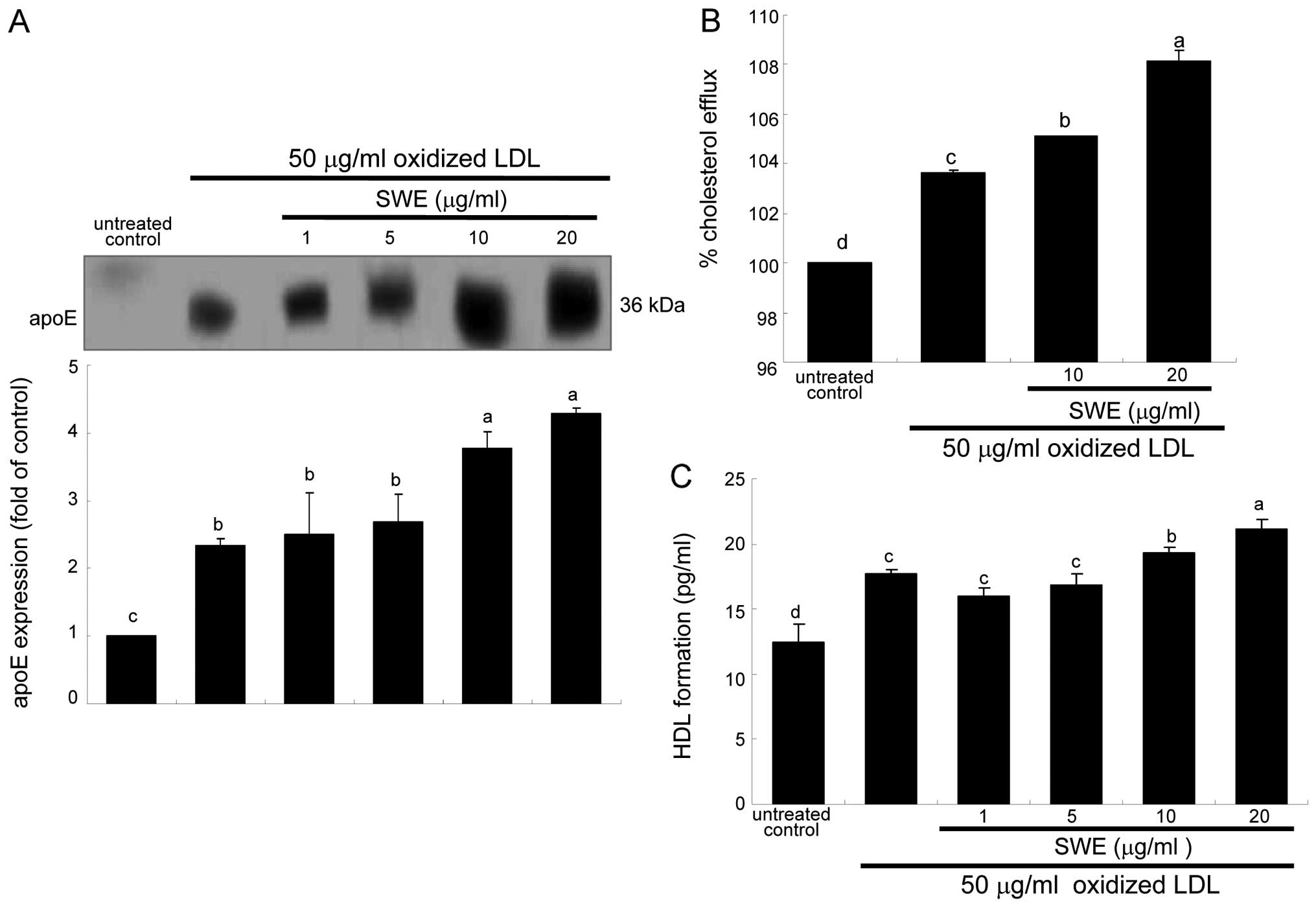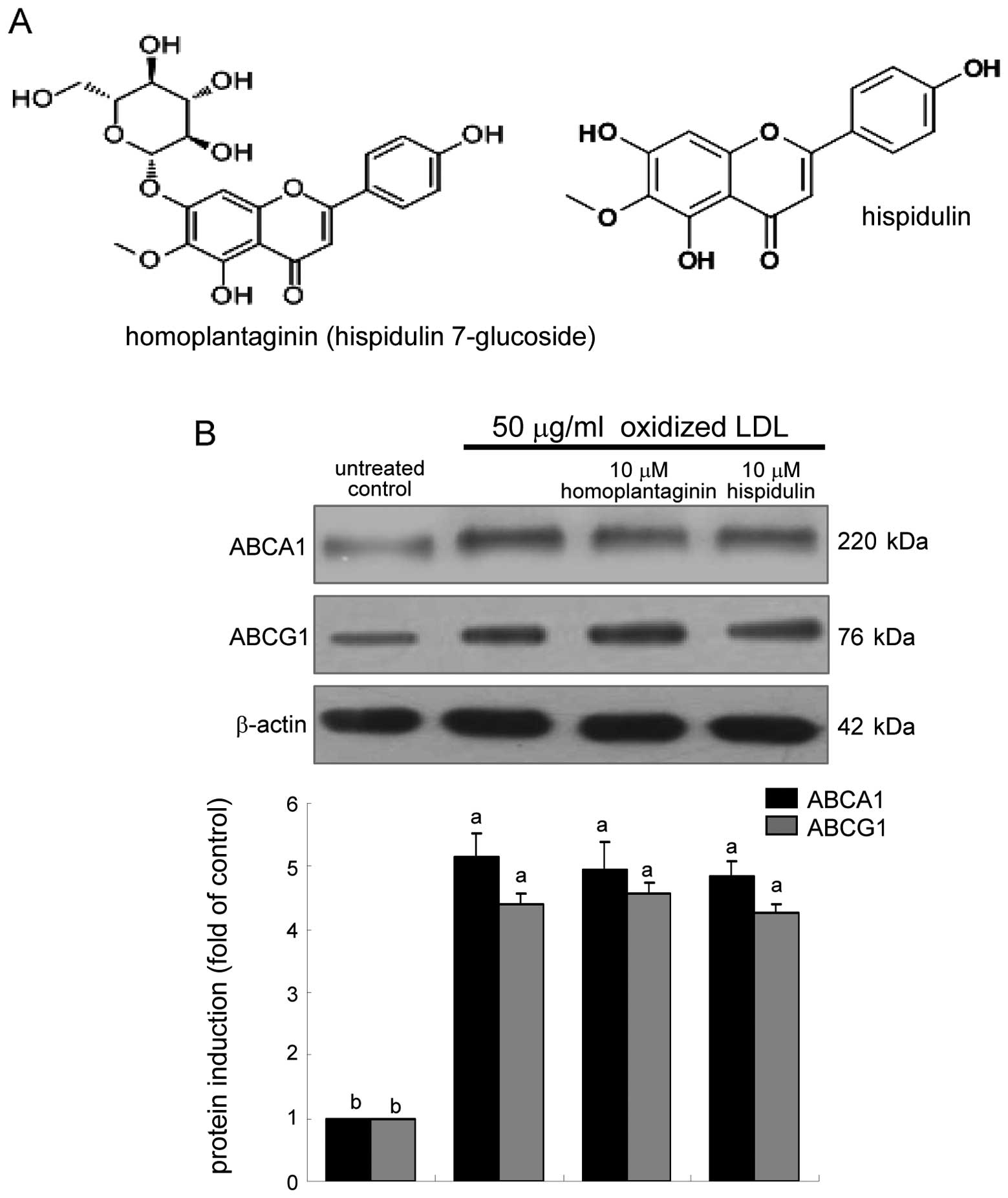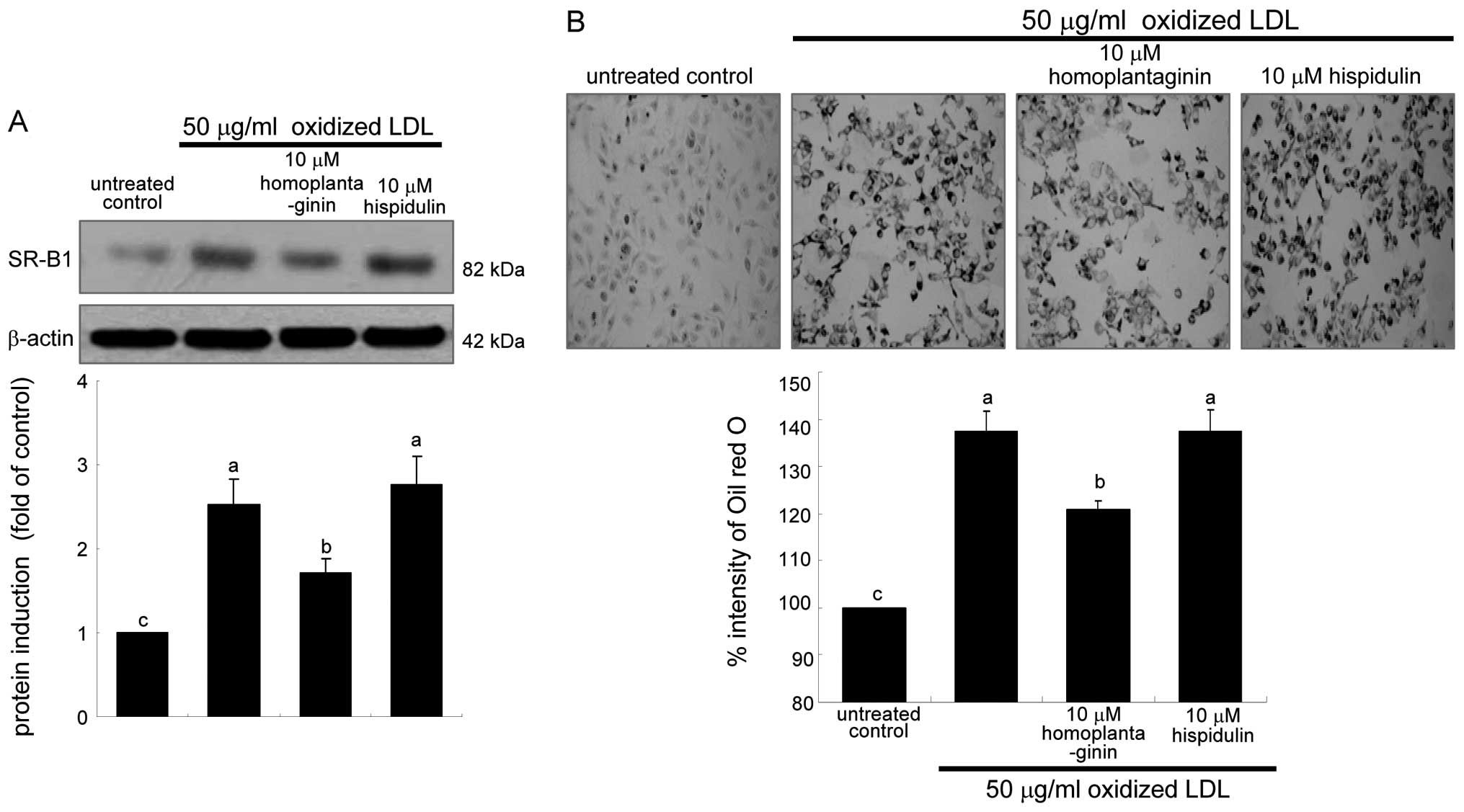Sage weed (Salvia plebeia) extract antagonizes foam cell formation and promotes cholesterol efflux in murine macrophages
- Authors:
- Published online on: August 20, 2012 https://doi.org/10.3892/ijmm.2012.1103
- Pages: 1105-1112
Abstract
Introduction
Oxidized low-density lipoproteins (LDL) uptake is a key initial event in atherogenesis. Foam cell formation plays a critical role in the development of atherosclerosis. Oxidized LDL is taken up by several receptors, such as scavenger receptor (SR) class A (SR-A), SR-B1 (CD36), and macrophage CD68 (1). Macrophage SR-B1 is the membrane receptors responsible for oxidized LDL uptake and facilitates the intracellular lipid accumulation (2). After oxidized LDL is taken up by macrophages, oxidized LDL cholesterol is degraded to oxysterols or free cholesterols in the lysosomes (3). The resulted oxysterols influence the formation of atherosclerotic plaques and are thought to have a central role in promoting atherogenesis (4). It has been speculated that oxysterols may represent the most toxic form of oxidized lipids in LDL (5). Thus, potential agents blunting oxidized LDL uptake leading to production of oxysterols are considered anti-atherogenic. However, the underlying mechanisms by which the agents antagonize oxidized LDL uptake and oxysterol formation by diverse stimulators remain to be elucidated.
The removal of oxidized lipids from artery wall is arbitrated by reverse cholesterol transport, the process involving the membrane proteins of ATP-binding membrane cassette transport protein A1 (ABCA1) and ATP-binding cassette transporter G1 (ABCG1) (6,7). ABCA1 is involved in the exporting of cholesterol and phospholipids from peripheral cells to lipid-poor apolipoprotein A1 (apoA1) to generate precursors for HDL particles (6,8). ABCG1 mediates oxysterol efflux from oxidized LDL-loaded macrophages, and the exported oxysterol by ABCG1 pathway can be selectively taken up by hepatocytes (7). Accordingly, ABCA1 and ABCG1 play a pivotal role in encumbering atherogenesis by promoting the efflux of cholesterol and oxysterols. Macrophages secrete high levels of apoE and cholesterol efflux from macrophages to apoE has been shown to decrease foam cell formation and prevent atherosclerosis (9). Furthermore, a recent study has shown a novel function of apoE as a significant determinant of cholesterol efflux in macrophages (10). ApoE associated with ApoB-carrying lipoproteins plays an upregulatory role on ABCA1 expression via induction of Sp1.
Sage weed (Salvia plebeia R. Br.) is an annual or biennial, hairy herb broadly distributed in many countries including China, India, Iran and Australia. Sage weed has long been used as a folk medicine in Asia and its medicinal properties are being more seriously investigated (11). Crude extract of Salvia plebeia exhibited antioxidant activity, and antioxidant compounds were isolated and identified as royleanonic acid, hispidulin and eupatorin (11). The ethanol extract of Salvia plebeia possess anti-inflammatory and anti-angiogenic, anti-nociceptive and antioxidant activities (12). Antioxidative activity and nitrite scavenging ability were observed in methanol extract from Salvia plebeia (13). However, there are no reports demonstrating anti-atherogenic activity of sage weed extract and its constituents.
Based on literature evidence that manipulating cellular cholesterol flux of peripheral cells and macrophages can be anti-atherogenic, this study hypothesized that sage weed methanol extract (SWE) improved macrophage cholesterol handling in oxidized LDL-loaded macrophages. To test this hypothesis, this study elucidated oxidized LDL uptake and cholesterol efflux in J774A1 murine macrophages treated with submicromolar SWE and its components of homoplantaginin and hispidulin. The aims of this study were to investigate the pathways mediating the removal of oxysterols and cholesterol from oxidized LDL-loaded macrophages. SR-B1 induction was measured for oxidized LDL uptake, and ABCA1 and ABCG1 expression was determined for apoE-mediated cholesterol efflux in a lipid-laden macrophages.
Materials and methods
Materials
Dulbecco’s modified Eagle’s medium (DMEM)chemicals, fatty acid-free bovine serum albumin (BSA) and Oil red O were provided by Sigma-Aldrich Chemical (St. Louis, MO), as were all other reagents, unless specifically stated otherwise. Fetal bovine serum and penicillin-streptomycin were obtained from Lonza (Walkersville, MD). SR-B1 antibody was supplied by Santa Cruz Biotechnology (Santa Cruz, CA). ABCA1 and ABCG1 antibodies were purchased from Novus Biologicals (Littleton, CO). Apolipoprotein (apo) E antibody was obtained from Abcam (Cambridge, UK). β-actin antibody was provided from Sigma Chemicals. Horseradish peroxidase-conjugated goat anti-rabbit IgG and rabbit anti-mouse IgG were supplied by Jackson Immuno Research Laboratory (West Grove, PA). Homoplantaginin and hispidulin were supplied by Shanghai Tauto Biotech Co., Ltd. (Shanghai, China).
Preparation of SWE
Sage weeds (Salvia plebeia R.Br.) were purchased from Dae Kwang Herb (Chuncheon, Korea). The voucher specimen (RIC-22) was deposited at Regional Innovation Center (Hallym University, Chuncheon, Korea). The dried whole parts of sage weeds were pulverized and extracted with 100% methanol for 4 h at 65°C (5L, 3 times). The liquid extract was evaporated in vacuo to give crude SWE. In the experiments, SWE, homoplantaginin and hispidulin were dissolved in dimethyl sulfoxide (DMSO) for live culture with cells; its final culture concentration was ≤0.1%.
Preparation and oxidation of human plasma LDL
Human plasma LDL was prepared by a discontinuous density gradient ultra-centrifugation as previously described (14). Pooled human normolipidemic plasma LDL fraction was dialyzed overnight against 0.154 mM NaCl and 0.01% EDTA (pH 7.4) at 4°C and used within 4 weeks. Protein concentration of the plasma LDL fraction was measured by the Lowry method (15), and the concentrations of triacylglycerol, total cholesterol and phospholipids were determined using diagnostic kits (Asan Pharmaceuticals, Hwasung, Korea).
Oxidized LDL was prepared by incubating LDL fraction with 10 μM CuSO4 (Cu2+) in F-10 medium at 37°C for 24 h. The LDL oxidation was routinely checked using TBARS concentration and eletrophoretic mobility assay (16). Aliquots of oxidized LDL were run on a 0.8% agarose eletrophoresis gel in barbital buffer (pH 8.6) to measure eletrophoretic mobility. Gel photographs were obtained using a Polaroid film (Polaroid, Wayland, MA).
Cell culture
The macrophage-like cell line J774A1 (mouse histocytic lymphoma cells) were grown in DMEM supplemented with 10% FBS at 37°C in a humidified atmosphere of 5% CO2 in air. Macrophages were pre-treated with 1–20 μg/ml SWE, 10 μM homoplantaginin, or 10 μM hispidulin and exposed to 50 μg/ml cholesterol-oxidized LDL for various times. For the lipid uptake, macrophages were incubated in DMEM supplemented with 0.4% fatty acid-free BSA.
Lipid uptake
Oil red O staining was performed to detect foam cells of macrophages. Oil red O is a fat-soluble diazo dye staining neutral triglycerides and some lipoproteins (2). J774A1 cells cultured with 50 μg/ml oxidized LDL were washed with phosphate buffered saline (PBS) containing 0.05% Tween-20, and fixed in 4% ice-cold formaldehyde for 1 h. Subsequently, 0.5% oil red O dissolved in 60% 2-propanol was added to cells for 1 h. After mounting with aqueous mounting medium, images were obtained by using an optical microscope. Oil red O staining was quantified by dissolving stained cells in 100% isopropanol with a spectrophotometer at λ/nm = 490.
Western blot analysis
Western blot analysis was performed using whole cell extracts from J774A1 macrophage as previously described (17). Cells were lysed in a lysis buffer containing 1% β-mercaptoethanol, 1 M β-glycerophosphate, 0.1 M Na3VO4, 0.5 M NaF and protease inhibitor cocktail. Equal protein amounts of cell lysates and equal volumes of culture media were electrophoresed on 6–12% SDS-PAGE and transferred onto a nitrocellulose membrane. After blocking non-specific binding with 5% skim milk for 3 h, the membrane was incubated overnight at 4°C with polyclonal rabbit antibodies of SR-B1, ABCA1, ABCG1 and apoE. After three washes with Tris-buffered saline-Tween-20, the membrane was incubated for 1 h with a goat anti-rabbit IgG or a rabbit anti-mouse IgG conjugated to horseradish peroxidase (HRP). The individual protein level was determined using immobilon western chemiluminescent horseradish peroxidase substrate (Millipore Corp., Billerica, MA) and Agfa X-ray film (Agfa-Gevaert, Belgium). Incubation with monoclonal mouse β-actin antibody was also performed for comparative controls.
Quantitative RT-PCR analysis
Following culture protocols, total RNA was isolated from J774A1 macrophages using a commercially available TRIzol reagent kit (Molecular Research Center, Cincinnati, OH). The RNA (5 μg) was reverse transcribed with 200 U of reverse transcriptase (Promega Corp., Madison, WI) and 0.5 g/l oligo-(dT)15 primer (Bioneer, Korea). RT-PCR analysis was also performed for semi-quantifying the levels of mRNA transcripts of SR-B1, ABCA1 and ABCG1. The PCR conditions for SR-B1 [5′-ATG GGC CAG CGT GCT TTT ATG A-3′ (forward), 5′-AAC CAC AGC AAC GGC AGA ACT A-3′ (reverse, 752 bp)] and ABCA1 [5′-AGC TGC CCC ATC ATG TAA AG-3′ (forward), 5′-GGG AGA AGA GCG TGC TAA TG-3′ (reverse, 580 bp) were 94°C (3 min), and 30 cycles at 94°C (30 sec), 60°C (45 sec) and 72°C (45 sec). Moreover, the condition for ABCG1 [5′-CCA AGT GGT GTC TCT GAT GA-3′ (forward), 5′-CTG AGG AAG GTC CTC TTG AA-3′ (reverse, 450 bp)] was 94°C (3 min), and 28 cycles at 94°C (30 sec), 55°C (45 sec) and 72°C (45 sec). The housekeeping gene GAPDH [5′-AAC TTT GGC ATT GTG GAA GGG-3′ (forward), 5′-GAC ACA TTG GGG GTA GGA ACA C-3′ (reverse, 224 bp)] was used for an internal normalization for the co-amplification with the respective gene.
Cholesterol efflux assay
J774A1 macrophages were treated with 1–20 μg/ml SWE for 12 h and then equilibrated with 1 μg/ml 3-dodecanoyl-NBD-labeled cholesterol (Cayman Chemical, Ann Arbor, MI) for additional 6 h. Cells exposed to NBD-labeled cholesterol were washed with PBS and incubated in DMEM for 6 h. The fluorescence-labeled cholesterol released from cells into medium for 6 h was detected at wavelength range λ = 485–538 nm by using a fluorometer. Cholesterol efflux was expressed as percent fluorescence in medium relative to total fluorescence.
Enzyme-linked immunosorbent assay (ELISA)
Following culture protocols, culture media were collected to measure HDL formation by using sandwich ELISA kits (Uscn Life Science Inc., Wuhan, China). After reacting to collected media on microtiter plate, wells pre-coated with a biotinconjugated antibody specific to HDL, avidin-conjugated to HRP was added to microplate wells and incubated. The TMB substrate solution was added to wells for detecting color change and the enzyme-substrate reaction was terminated by the addition of 3 N sulphuric acid solution. The color change was measured spectrophotometrically at λ = 450 nm.
Data analysis
The results are presented as mean ± SEM. Statistical analyses were conducted using the Statistical Analysis Statistical software package version 6.12 (SAS institute, Cary, NC). One-way ANOVA was used to determine the inhibitory effects of SWE on the cholesterol handling of macrophages. Differences among the treatment groups were analyzed with Duncan’s multiple range test and were considered to be significant at P≤0.05.
Results
Suppression of SR-B1 expression by SWE
It has been shown that the uptake of oxidized LDL require SR induction in macrophages (1,2). As expected, oxidized LDL hastened SR-B1 expression rapidly within 2 h, which was sustained up to 8 h (data not shown). When oxidized LDL was treated for 6 h, the SR-B1 expression diminished in a dose-dependent manner due to the presence of 1–20 μg/ml SWE (Fig. 1A). This study investigated whether the suppression of SR-B1 induction by SWE was achieved at its transcriptional level. Quantitative RT-PCR data revealed that ≥10 μg/ml SWE lowered oxidized LDL-elevated SR-B1 mRNA level of macrophages (Fig. 1B). It should be noted that treating macrophages with oxidized LDL markedly elevated their SR-B1 mRNA level within 2 h (data not shown).
Effects of SWE on reduction of foam cell formation
This study examined intracellular lipid accumulation in macrophages by using oil red O staining. There was strong reddish staining observed in macrophages exposed to 50 μg/ml oxidized LDL for 18 h. This indicates cellular accumulation of lipids through the upregulated SR-B1. When ≥5 μg/ml SWE was applied to macrophages for 18 h, reddish lipid droplets disappeared (Fig. 2). Accordingly, SWE delayed foam cell formation in macrophages exposed to 50 μg/ml oxidized LDL.
Enhancement of ABCA1 and ABCG1 expression by SWE
The membrane proteins of ABCA1 and ABCG1 are responsible for cholesterol efflux from lipid-laden macrophages (6,7). The application of 50 μg/ml oxidized LDL to macrophages promoted the expression of ABCA1 and ABCG1 8 h after its treatment (data not shown). When ≥5 μg/ml SWE was applied to macrophages exposed to oxidized LDL, the induction of these proteins was further upregulated (Fig. 3). Accordingly, ≥5 μg/ml SWE may promote cholesterol efflux from lipid-laden foam cells. In addition, the ABCA1 and ABCG1 mRNA levels were elevated within 2 h in macrophages exposed to 50 μg/ml oxidized LDL, as determined by quantitative RT-PCR assay. The transcription of ABCA1 and ABCG1 was further enhanced in lipid-laden macrophages supplemented with ≥10 μg/ml SWE (Fig. 4).
Acceleration of cholesterol efflux by SWE
It has been shown that cholesterol efflux from macrophages to apoE decreases foam cell formation and prevents atherosclerosis (8,10). This study showed that apoE was secreted from 50 μg/ml oxidized LDL-added macrophages (Fig. 5A). In lipid-laden macrophages supplemented with ≥10 μg/ml SWE, apoE secretion was enhanced at protein levels (Fig. 5A). Thus, it is deemed that ≥10 μg/ml SWE promoted cholesterol efflux through ABCA1 and ABCG1 upregulated by apoE (10).
SWE boosted the induction of ABCA1 and ABCG1 proteins at the transcriptional levels (Fig. 3). Consistently, cholesterol efflux was enhanced in oxidized LDL-treated macrophages (Fig. 5B). The efflux was further accelerated in macrophages exposed to 50 μg/ml oxidized LDL and treated with ≥10 μg/ml SWE (Fig. 5B). In addition, the HDL formation was enhanced at levels of protein in lipid-laden macrophages treated with oxidized LDL, which was further highly enhanced by 20 μg/ml SWE (Fig. 5C).
Inhibitory effects of homoplantaginin on uptake of oxidized LDL
The SWE application to oxidized LDL-treated macrophages upregulated the cellular expression of ABCA1 and ABCG1 (Fig. 3). This study elucidated whether homoplantaginin and hispidulin, the single compounds present in sage weeds (Fig. 6A), influenced cholesterol efflux from lipid-laden foam cells. Homoplantaginin and hispidulin did not modulate the cellular expression of ABCA1 and ABCG1 upregulated in oxidized LDL-exposed macrophages (Fig. 6B). In contrast, 10 μM homoplantaginin, but not hispidulin inhibited SR-B1 induction and consequent uptake of oxidized LDL in J774A.1 macrophages (Fig. 7). These results indicate that SWE containing homoplantaginin retarded foam cell formation as an anti-atherogenic agent.
Discussion
There are five major observations extracted from this study. i) SWE at ≥10 μg/ml inhibited SR-B1 expression accounting for oxidized LDL uptake and cellular lipid accumulation in J774A1 murine macrophages. ii) Oxidized LDL enhanced ABCA1 and ABCG1 expression, which was further promoted at transcriptional and protein levels by ≥5 μg/ml SWE. iii) SWE accelerated apoE secretion from lipid-laden macrophages. iv) SWE promoted cholesterol efflux and HDL formation through inducing ABCA1 and ABCG1 expression. v) Homoplantaginin but not hispidulin, the single components of sage weeds, alleviated SR-B1 induction and foam cell formation. Accordingly, it is deemed that SWE antagonized foam cell formation in the vascular wall and promoted the export of cholesterol from lipid-laden macrophages to the reverse cholesterol transport. Therefore, SWE may be a therapeutic anti-atherogenic agent in the development of atherosclerosis.
Oxidized LDL uptake, is a key initial event in atherogenesis, steering foam cell formation toward the development of atherosclerosis. Modified LDL is taken up mainly by SR-A and SR-B1 of macrophages (1). Especially the macrophage SR-B1 is responsible for oxidized LDL uptake and facilitates the intracellular accumulation of lipid droplets (2,18). The present study revealed that SWE dampened foam cell formation augmented within 18 h after treating oxidized LDL. This inhibition was mediated most likely through downregulating SR-B1 induction stimulated by oxidized LDL. Intracellular lipids in the cytoplasm of macrophages are shown to be degraded to phospholipids, oxysterols and free cholesterol in the lysosome (3,19). Cytotoxic oxysterols induce macrophage apoptosis and play a central role in promoting atherogenesis with the build-up of atherosclerotic plaques (4,5). Accordingly, SWE is a potential anti-atherogenic agent blunting oxidized LDL uptake leading to production of oxysterols. It should be noted that homoplantaginin may play a role in antagonizing foam cell formation by SWE. The antagonizing activity appeared to require the glucose moiety of homoplataginin. However, the underlying mechanisms by which SWE interrupted oxidized LDL uptake remain to be elucidated. The inhibition of oxidized LDL-induced SR-B1 induction by SWE was achieved at its transcriptional level. Similarly, soy pinitol has inhibitory effects on foam cell formation by reducing lipid accumulation and macrophage SR expression via its insulin-like action (20).
Sage weed as a folk medicine has been investigated for its medicinal properties (11). The ethanol extract of Salvia plebeia possessed anti-inflammatory and anti-angiogenic, anti-nociceptive and antioxidant activities (12). Numerous antioxidant compounds such as royleanonic acid, hispidulin and eupatorin were isolated and identified in crude extract of sage weed (11). Chemical fingerprint and quantitative analysis showed that seven bioactive compounds of homoplantaginin, hispidulin, luteolin, nepetin, caffeic acid, luteolin-7-glucoside, and nepetin-7-glucoside contained as constituents in Salvia plebeia (21). The major compound of Salvia plebeia, homoplantaginin, has a protective and therapeutic effect on hepatocyte injury, which might be associated with its antioxidant activity (21,22). Unfortunately, the present study did not identify the constituents of SWE. However, this study found that homoplataginin, a major constituent in Salvia plebeia, inhibited cellular SR-B1 induction and oxidized LDL uptake of lipid-laden macrophages. There have been no reports demonstrating anti-atherogenic activity of SWE and homoplantaginin. It can be speculated that homoplataginin present in sage weeds may exert anti-atherogenic activity dampening SR-B1 induction.
The export of cholesterol and lipids from macrophages is arbitrated by reverse cholesterol transport, the process involving ABCA1 and ABCG1 (6,7). These proteins mediate the movement of cholesterol between cells and extracellular acceptors (23). ABCA1 is responsible for the export of cholesterol and phospholipids to generate precursors for HDL particles (6,8). In addition, ABCG1 mediates oxysterol efflux from oxidized LDL-loaded macrophages (7). Accordingly, the upregulation of ABCA1 and ABCG1 is considered anti-atherogenic. This study showed that SWE further upregulated ABCA1 and ABCG1 of lipid-laden foam cells and elevated cholesterol efflux. Thus, SWE may be a therapeutically athero-protective agent against the development of atherosclerosis. Several studies show that hispidulin, another compound present in Salvia plebeia, exerts anticancer effects and has the potential to be a chemopreventive and therapeutic agent (24,25). Nevertheless, this compound is unknown in the anti-atherogenic activity upregulating cholesterol efflux. This study failed to show promoting effects of homoplantaginin and hispidulin, on ABCA1 expression. However, caffeic acid, one of Salvia plebeia constituents, enhanced cholesterol efflux from THP-1 macrophages mediated by HDL, and induced expression of ABCG1 and SR-BI but not ABCA1 (26). Thus, other unknown components appeared to be responsibe for increasing cholesterol efflux and HDL formation by SWE.
ApoE is essential for the normal catabolism of triglyceride-rich lipoprotein constituents. There are numerous studies in regard of apoE-mediated cholesterol efflux. Cholesterol efflux from macrophages to apoE diminishes foam cell formation and prevents atherosclerosis (9,10). However, very little is known about the apoE activity related to cholesterol transporters. Several membrane transporters related to cholesterol efflux include ABCA1, ABCG1, SR-B1 and caveolin-1 (27). A recent study showed that apoE is involved in cholesterol efflux in macrophages by upregulating ABCA1 expression (10). This study showed that SWE was an apoE promoter enhancing its secretion in oxidized LDL-loaded macrophages. This may be an athero-protective mechanism by which SWE boosted ABCA1 expression and cholesterol efflux. Conversely, epigallocatechin-3-gallate attenuated downregulated ABCA1 and decreased cholesterol efflux to apoA1 in TNF-α-exposed macrophage foam cells (28).
In conclusion, this study demonstrated that SWE dampened oxidized LDL uptake through reducing SR-B1 expression at a transcriptional level and attenuated foam cell formation full of cholesterol in the cytoplasm of macrophages. Homoplantaginin but not hispidulin, major components of SWE, alleviated foam cell formation by downregulating of SR-B1 induction. In addition, SWE enhanced cholesterol efflux in oxidized LDL-loaded macrophages through further inducing ABCA1 and ABCG1 expression and apoE secretion. Other unknown components in SWE, but not homoplantaginin and hispidulin, appeared to be involved in HDL formation. Therefore, SWE may be a protective agent against atherosclerosis by inhibiting foam cell formation and boosting cholesterol efflux from lipid-laden macrophages.
Abbreviations:
|
ABCA1 |
ATP-binding cassette transporter A1 |
|
ABCG1 |
ATP-binding cassette transporter G1 |
|
apoE |
apolipoprotein E |
|
LDL |
low-density lipoproteins |
|
SR |
scavenger receptor |
|
SWE |
sage weed methanol extract |
Acknowledgements
This study was financially supported by Ministry for Food, Agriculture, Forestry and Fisheries (112085-3), National Research Foundation of Korea (2012012946), and by National Research Foundation of Korea through the Human Resource Training Project for Regional Innovation (2012-01-A-05-003-12-010100).



